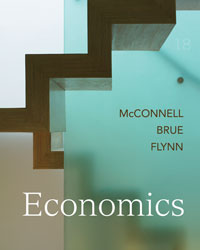
Economics (McConnell), 18th EditionChapter 26: Business Cycles, Unemployment, and InflationKey Questions1. What are the four phases of the business cycle? How long do business cycles last? How do seasonal variations and long-run trends complicate measurement of the business cycle? Why does the business cycle affect output and employment in capital goods industries and consumer durable goods industries more severely than in industries producing consumer nondurables? 2. Use the following data to calculate (a) the size of the labor force and (b) the official unemployment rate: total population, 500; population under 16 years of age or institutionalized, 120; not in labor force, 150; unemployed, 23; part-time workers looking for full-time jobs, 10. 3. Assume that in a particular year the natural rate of unemployment is 5 percent and the actual rate of unemployment is 9 percent. Use Okun's law to determine the size of the GDP gap in percentage-point terms. If the potential GDP is $500 billion in that year, how much output is being forgone because of cyclical unemployment? 4. If the CPI was 110 last year and is 121 this year, what is this year's rate of inflation? What is the "rule of 70"? How long would it take for the price level to double if inflation persisted at (a) 2, (b) 5, and (c) 10 percent per year? |  |















